With hundreds of success stories behind it, this step-by-step sourdough starter recipe shows you how to create your own bubbly starter in six days, no fancy tools required. Perfected over years of testing, this easy method is foolproof!
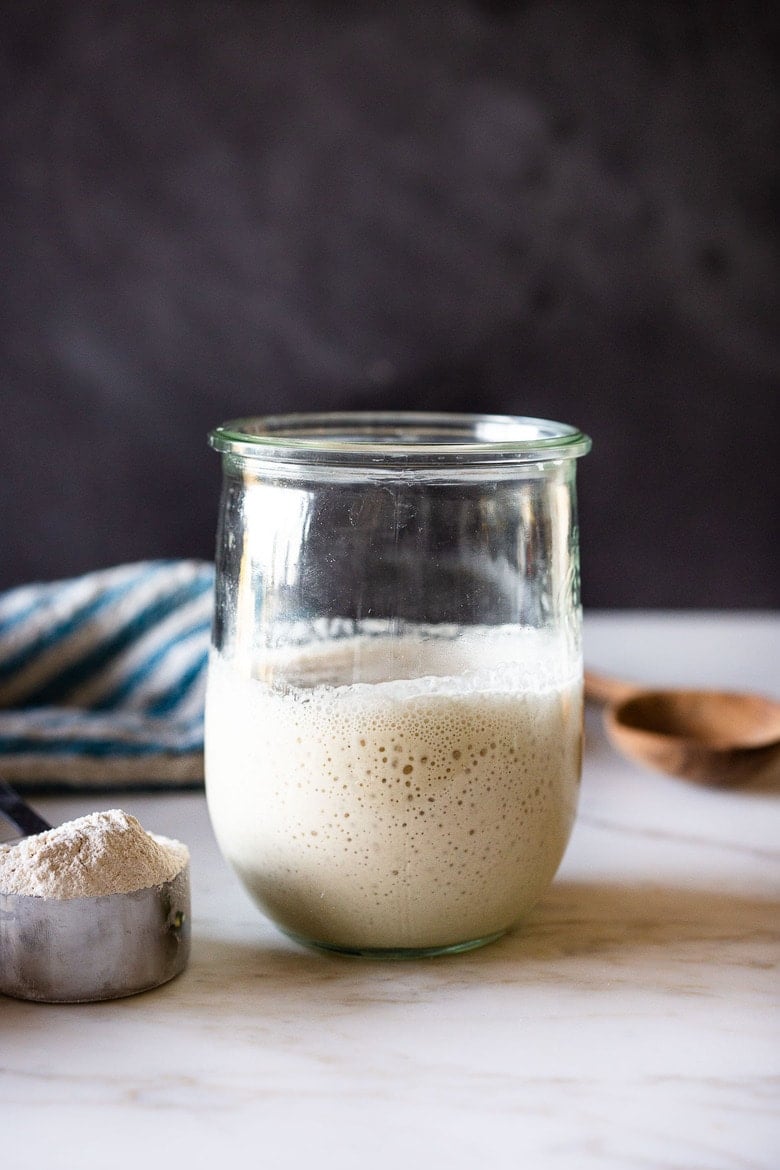
When you understand one thing through and through, you understand everything.
Shunryu Suzuki
With over 500 five-star reviews and hundreds of success stories, my chef's perfected sourdough starter guide has everything you need to make your own homemade starter. It is an easy process, and once you understand it, you’ll think to yourself, Why didn’t I do this sooner! In just six days, you'll be baking the most beautiful sourdough loaves! Just read all the success stories below.
What is Sourdough starter?
Sourdough starter is a “wild yeast” made from flour, water, and the natural wild yeast in the air. With a little care and patience, it ferments, and when strong and active, just a little bit of starter replaces commercial yeast and makes your bread rise, while transforming the gluten in the bread into something more easily digestible. Store-bought yeast is not needed!
How long will it take?
It takes 6-7 days to make sourdough starter from scratch. In colder climates, it can take up to 12 days, and in warmer climates, it may only take 5 days. Once you have a bubbling active starter that consistently rises and falls, you can bake sourdough bread, typically on day 7. For a primer, watch the 20-minute Sourdough Video below, where I personally walk you through each day.
Watch: How to Make Sourdough Starter From Bread Flour
Fast forward to Specific Day by video time (using scroll bar underneath video)
- Day 1 Morning: :23
- Day 2 Morning: 4:10
- Day 3 Morning: 7:00
- Day 3 Evening: 9:12
- Day 4 Morning: 11:50
- Day 4 Evening: 13:37
- Day 5 Morning: 14:45
- Day 6 Evening: 16:50
- Day 6 Morning: 18:12
- Day 6 Evening: 20:10
Best Sourdough Starter Ingredients
Sourdough Starter Equipment
- Jar – A wide-mouth quart jar or a Weck’s 1-liter tulip jar.
- Kitchen Scale – using a kitchen scale helps measure the flour and water more accurately – optional but handy.
- Thermometer – Knowing the temperature of the starter using a thermometer gives you great information!
Sourdough Starter Ingredients
- Flour – 5 lb bag of organic bread flour (plus 1-2 cups organic whole grain flour like rye flour or whole wheat flour). All-purpose flour is not reccommended. Whole grain flour has more wild yeast- and will help jump start your starter!
- Water – filtered water, tap water, or mineral water (specifically, San Pellegrino, for the correct mineral ratio). Distilled water does not have enough minerals.
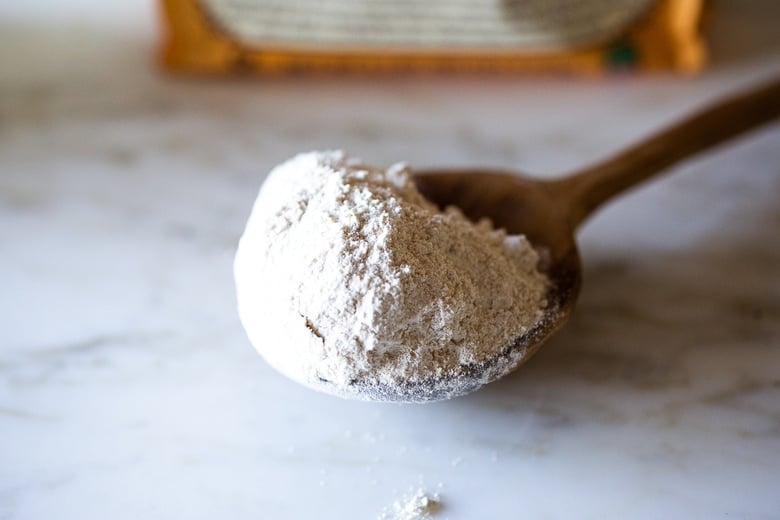
Understanding Your Sourdough Starter
The secret to making sourdough starter is understanding the process, your environment and your starter’s needs. Each starter is different and unique. Here, we’ll show you what to look for and most importantly, why.
- Think of sourdough starter as a yeast. Only in this case, instead of buying a packet of yeast from the store, you are making your own living “wild yeast” by fermenting flour and water. Once it’s bubbly and happy, it is very much like a very low-maintenance pet. Yes, you can even name it. Mine is called Vita.
- You must feed it (stir in a mixture of flour and water) once a week to keep your pet active and strong. We will show you how to tell when it is hungry and when to feed it.
- Some people believe that bread made with sourdough starter is actually better for you than bread made with yeast. Here and here are a few articles to get you started on your own research. While I’m not sure if this is scientifically proven, I do know that bread made with sourdough starter, tastes infinitely better, feels easier to digest, and has more complexity and better texture than bread made with commercial yeast. So if you are a bread lover, this is absolutely the way to go, as far as the quality of your finished bread.
How to Make Sourdough Starter from Bread Flour
*See the recipe card for detailed instructions.
For your first measurement, weigh the flour using a kitchen scale so you can get an idea of how the mixture should feel. Do not weigh the measuring cup! It should be like a thick paste, like peanut butter. If you need to add a little more water to incorporate the flour, that is OK too.
Day 1: Starting in the morning or at night, using a wide-mouth quart jar, tulip jar, mix 1 cup whole grain flour (120 grams) with 1/2 cup filtered water (120 grams) using a fork, making sure you’ve incorporated all the dry flour.
Place the lid lightly on top (using the Weck jar lid is really handy here) or a wet towel to keep moisture in, or plastic wrap- and let sit at room temperature (70-ish degrees) on the kitchen counter for 24-48 hours. If you are unsure how warm it is, use a kitchen thermometer and check it a few hours later. It is best at 70-75°F.
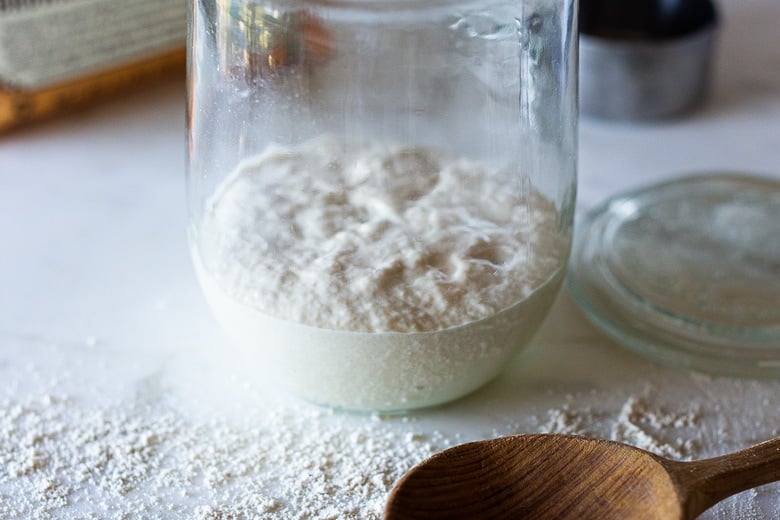
Day 2: After the first 24 hours, there may or may not be a bit of bubbling. Let the mixture rest until you see activity (bubbles or rising). Sometimes this takes 36 hours or even 48 hours, especially if the weather is very cold. When you see active bubbling, discard all but 1/2 cup of the starter (4 ounces).
To the remaining ½ cup of starter, stir in 1/2 cup lukewarm water (120 grams), and mix well with a fork. Add 1 cup of organic bread flour (120 grams) spooned and leveled. Stir until combined. Again, it should feel like a thick paste. If overly dry, feel free to add a bit more water. Cover again and allow the mixture to sit at room temperature for another 24 hours.
Day 3: After 24 hours, hopefully, you will see some bubbling or rising, and if not, let it go longer until you see some activity. Be patient. Depending on how warm your house is and how active your starter, you may need to feed it less often or more often, depending on when it gets “hungry”.
How to Know when to Feed your starter
Only feed your starter after it has peaked or looks “hungry”. Feeding it when it is “not hungry” will basically dilute all the growing yeast and make it lethargic. Better to underfeed than overfeed. How to tell if it is hungry?
- Look for “slide marks” (be sure to use a clean jar so you can see these clearly-see photo below).
- Thin and runny. The starter is liquid enough to pour out of the jar (when at room temperature).
- There is liquid at the top of the starter- a clear sign of hunger!
- Smells like acetone. The starter has processed all of the previous feeding and needs to be fed again.
In the photo below, the starter “peaked” at the top line, then slid down. I call these slide marks- indicating the starter is hungry.

This might be 12 hours, it might be 14, it might be 18, or 24, depending on the temp in your house. In very warm climates, it may only be 6-8 hours. In winter, this may take 36 hours. It is better to underfeed rather than overfeed.
For each feeding, discard all but 1/2 cup of the starter (keeping roughly ½-cup of starter in the jar). Add 1/2 cup water and 1 cup bread flour (spooned and leveled). Mix well, cover, and let this rest at room temperature for 12-24 hours or until the starter looks “hungry” again before repeating.
Day 4: Feed 1-2 times a day (only feeding when hungry), discarding all but 1/2 cup of starter each time. Feed 1 cup of bread flour and 1/2 cup of water.
TIP: It is typical on day 4 for the starter to slow down and stall a bit. This is OK. Just keep going, be patient, and look for the hunger signs, and only feed when clearly hungry. Hopefully, you’ll begin to see some rising and falling. It’s helpful to put the starter in a clean jar each day and mark the beginning level (with a sharpie, string or rubber band) so you can easily see this.
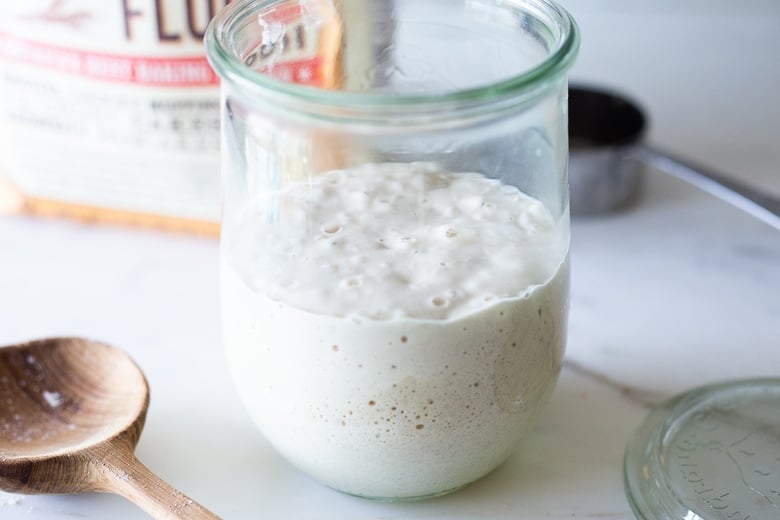
Above, you’ll see it peaking, and below, you’ll see it deflating and getting “hungry.” There may not be too much difference in the beginning, so look closely.
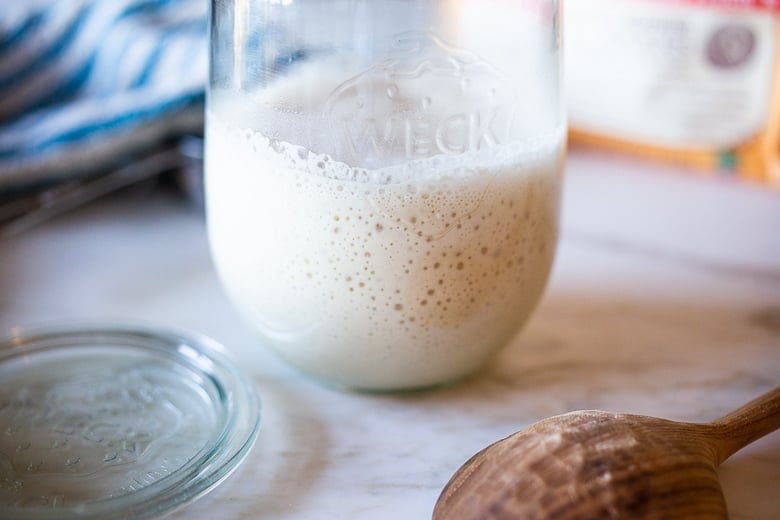
Understand that your starter has a schedule of its own; it is a living thing, so watch it and pay attention.
If your starter is not rising and falling, look at its consistency. As it metabolizes the flour and gets hungry, it will get runny and liquidy, like to the point where you can pour it right out of the jar. If it is still thick like paste, it’s not done metabolizing (eating) the flour.
Day 5: Feed again, 1-2 times, discarding all but a 1/2 cup of the starter each time. Add 1 cup of bread flour and 1/2 cup of lukewarm water. The starter should look visibly active, bubbling, rising, hopefully, close to doubling in size.
*Repeat day 5 until the starter is rising and falling predictably and is close to doubling in size within 6-8 hours.
If your starter is not rising but there is evidence of hunger (runny or liquid at the top), try these three things:
- Substitute 1/4 cup whole grain flour (add to ¾ cup white bread flour) on your next feeding.
- Use mineral water like San Pellegrino instead of water.
- Stir the starter a few times after feeding to allow more wild yeast from the kitchen to get inside.
DAY 6 Morning: Baking day! Give it one last feeding in the morning: this time discard all but a 1/3 cup. (The reason we are changing this to 1/3 cup is to feed it a little bit more.) Add 1 cup flour (120 grams) and 1/2 cup water, stir, and place it in a clean jar so you can see the activity clearly. You can use a Sharpie or place a rubber band around the jar to mark the beginning level.
How to Know When Your Bread Flour Sourdough Starter is Ready to Bake Bread
The starter should double in volume within 6-8 hours of feeding.
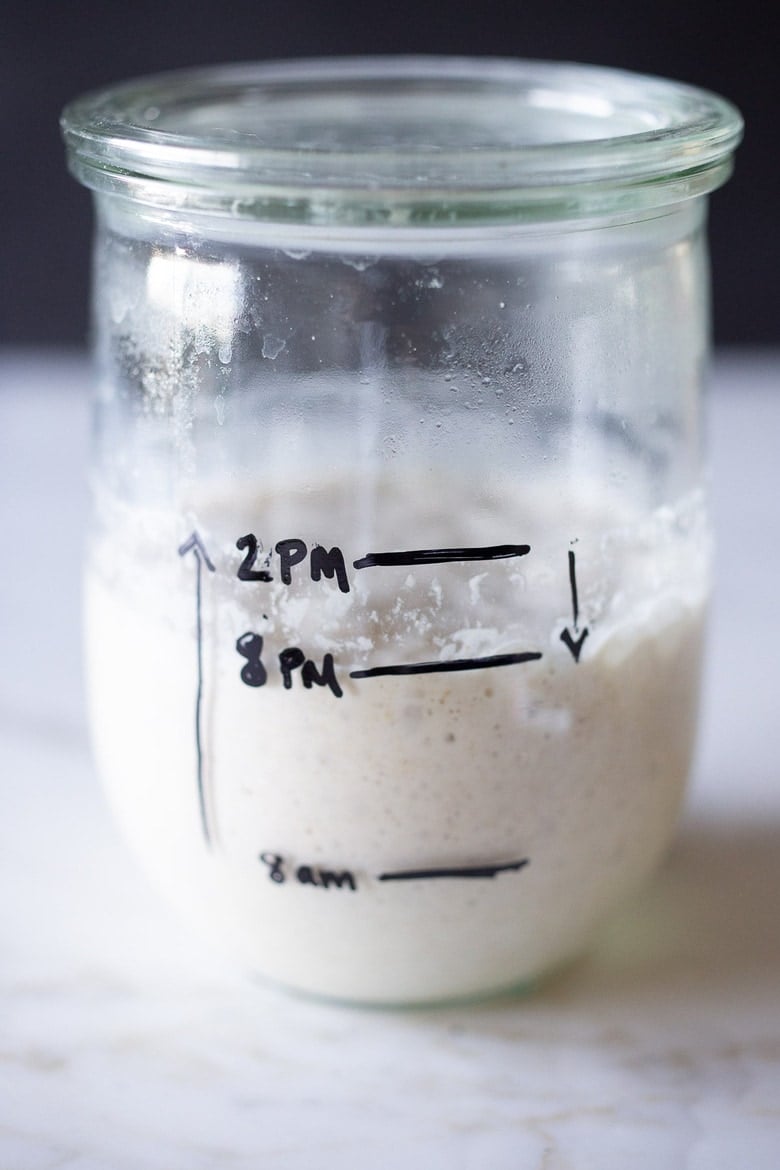
In the photo above, on the 6th day, the starter was fed at 8 am, it peaked around 2 pm, then it started deflating, and by 8 pm, it was “hungry” again. See those downward “slide” marks on the jar?
Do the Float Test
When the starter is at its peak, or just after, place a teaspoon of starter (just from the top, don’t stir it down) in a glass full of water; it should hopefully float. If it floats, success! Congrats. You can now make our sourdough bread…tonight!
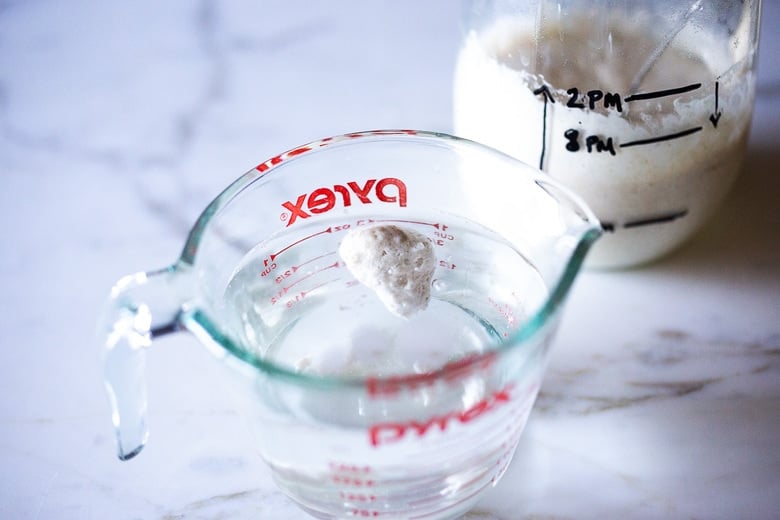
My Best Sourdough Baking Tip. When baking bread, always use a hungry starter that has already peaked.
STARTER DOES NOT FLOAT? If it doubles in size but does not float, you can still try baking a loaf if it doubles within 6-8 hours of feeding it.
At this point, if your starter does not double in size within 6-8 hours of feeding, don’t give up! Often, it just takes longer, especially during the winter months. Continue feeding one to two times a day until you see a consistent, predictable rise and fall.
Read the troubleshooting section. If you need to take a break, put it in the fridge and try it again up to a week later. Don’t toss it!
Day 6 Evening: Let’s Bake! Use 1/3 cup starter to make this sourdough bread recipe and place the remaining starter (or if not making bread, place all of it) in the refrigerator, and feed it at least once a week, reserving ½ cup starter, before feeding it the usual 1 cup bread flour, 1/2 cup water.
TROUBLESHOOTING the Best Sourdough Starter
- SMELL: Starter should smell sweet, tangy, earthy, like a wet horse – not “bad”. If it really smells foul or unpleasant, you may have used an unclean jar, an unclean utensil, or somehow introduced other bad bacteria. I would start over.
- NO ACTION: On day 4-5 it is typically for it to slow down. If your starter is not rising at all but there is evidence of hunger (liquid at the top, or bubbles) try 3 things. First substitute 1/4 cup whole grain flour (add to ¾ cup white bread flour) on your next feeding. If no rise, then try using mineral water, specifically San Pellegrino instead of water. San Pelligrino specifically has the right mineral ratio, I have great luck with it. Others not so much! Also try stirring the starter a couple of hours after feeding, a couple of times throughout the day to allow wild yeast from the room to get in there. Lastly, you could try pineapple juice instead of water.
- FLOUR: Try to use fresh milled whole grain flour to start, then organic BREAD FLOUR. The more wild yeast in the flour, the better your starter will do, so smaller brands like Bob’s Red Mill seem to do better than bigger conventional brands that have been overly processed. It is totally OK to mix flours and to switch them up- this adds different kinds of wild yeast- a good thing!
- DO NOT overfeed. For example, maybe feeding 2 x day at 12-hour intervals is too often. You want to feed after the starter has peaked, then deflated (see photo above- you’ll see some slide marks on the jar) and this tells you that it is hungry. If you feed the starter before it has had a chance to metabolize (or eat) all the flour (before peaking) and then you discard part of it, and feed it again, you are actually diluting all that amazing bacteria, weakening your starter. So it’s all about watching your starter in your home. If you are not seeing rising and falling, but notice the starter just gets liquidy, this too is a sign of “hunger”. Or if it gets runny enough to pour out of the jar, another sign it is hungry. There are lots of variables here. Just be patient, pay attention and watch. This is a living thing- it doesn’t care about time schedules and recipes or what it “should” do. It will “eat” when it is “hungry” and sometimes it likes to eat slowly. 😉
- TIME: It may take longer than 6 days in colder environments. Use a kitchen thermometer and take its temp. Is it over 65F? Find a place where it can be warm. In the oven with the light on, or in an upper cupboard (heat rises). Sometimes it takes 12-14 days! Be patient, keep going. If it is doing absolutely nothing, leave it out on the counter for 24-48 hours and see what happens. If you run out of flour or need a break, don’t just toss it; put it in the fridge and see if you can get it going a few days later.
- ACIDITY: If you still can’t get that starter going, some people recommend subbing pineapple juice for the water for one feeding- raising the acidity level. My good friend just tried this and it got hers going.
- LIQUID: If you see any liquid at the top of your starter, it means your starter is hungry. So, yes it’s still alive which is a good thing! You can stir the liquid in, or pour the liquid out, either way, but feed it. This is a sign that you may need to feed it more often.
- MOLD: if you see any discoloring or mold on the surface, starter was probably contaminated. If it is only on the surface, it is probably ok to save. Scrape it off, save 1/2 cup of the underneath starter, and keep going, using a clean jar. Feed, smell, use your best judgment.
- FLOAT TEST: Try testing when your starter is peaking. Take a spoonful from the top without stirring it down. If your starter is rising and falling consistently, but not passing the float test and it has been over 8-10 days, just try baking a loaf. People are having luck with good loaves without passing the float test. It may be the flour…
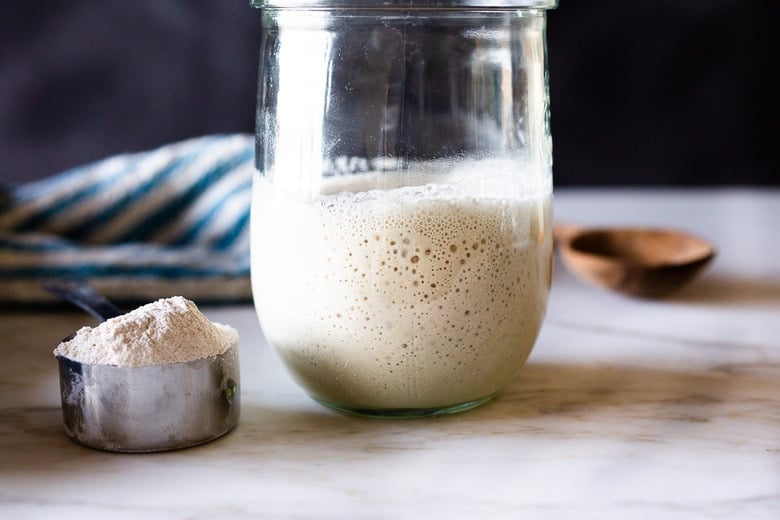
Sourdough Starter with Bread Flour Storage Tips
- REFRIGERATE & FEED AT LEAST ONCE A WEEK: Pick a scheduled day and try to stick with it, always reserving 1/2 cup and feeding it 1 cup flour and 1/2 cup water. Discard the remaining, give it away, or keep the discard in a separate container for sourdough pancakes, sourdough buns, banana bread, biscuits, etc. I usually don’t feed the discard unless I give it away.
- If you forget to feed it one week, it is most likely OK; feed it 1-2 times a day for 1-3 days in a row to revive it (keeping it out on the counter) until bubbly and active and doubles within 6 hours. I’ve left my starter for a month on vacation (in the fridge) without feeding and simply revived it by feeding it 3 days in a row, 1-2 x day. It’s surprisingly hard to kill. You can also freeze it for more extended storage.
- This batch of starter will allow you to bake 2 loaves of bread per week with enough left to feed for the next week. If you want to bake more often, you can keep it out and feed it 1-2 x daily. Or if baking every few days, you can pull it out of the fridge, feed it 10 hours before using, leaving it out, use what you need while it is peaking (or slightly after), then put it back in the fridge that evening. Do the same thing a few days later when ready to use again. So this would be feeding 2-3 times a week, best if baking 4-5 times a week.
- If you are not actively baking, you can maintain a smaller amount of starter using the same ratios.
- You can also freeze the sourdough starter if you’re leaving on a long trip.
FAQs for this Sourdough Starter Recipe with Bread Flour
Yes. While you are building your starter, during the first week, it is the simplest, easiest, fastest, and most economical way to create a healthy starter. (Or save it separately -in the fridge- and use it in Pancakes, Waffles, Buns, or Biscuits. ) This is because you always have to feed it two times its volume in flour. For example-if you kept all the 1 1/2 cups of starter, you would have to feed it 3 cups of flour (instead of keeping just a 1/2 cup and only feeding it ONE cup). Discarding will shorten the fermentation process, require less flour in the long run, and create a stronger starter. Once your starter is “established” after the first week- then you can give it away to friends or use it in pizza dough, pancakes, etc).
This recipe for Sourdough Starter takes 6 days (or up to 12 days if it is very cold where you live).
The only ingredients you need to get started are flour (bread flour and whole grain flour) and water.
What is the biggest mistake you can make with your sourdough starter?
The most common mistake is overfeeding, which weakens your starter instead of making it stronger. The secret is to watch for signs of hunger-bubbles slowing down, slide marks in the jar, or liquid on top-before feeding. Once you learn to read your starter's natural rhythm, it will stay bubbly, active, and ready to bake with.
It's surprisingly simple to make a sourdough starter! The process is hands-off and only takes a few minutes each day. The key is consistency: feed it regularly and keep it at a steady temperature. Once you get into the rhythm, caring for your starter becomes second nature, and you'll be rewarded with a healthy, bubbly culture for all your baking.
How to use Beginner Sourdough Starter
- See all our Sourdough Recipes!
- Sourdough Scones
- Sourdough Crackers
- Sourdough Biscuits
- Sourdough English Muffins
- Sourdough Tortillas!
- Vegan Banana Bread
- Overnight Sourdough Waffles
More from Feasting At Home
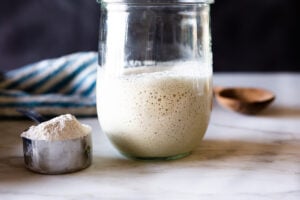
Sourdough Starter Recipe with Bread Flour
- Prep Time: 30
- Cook Time: 6 days
- Total Time: 144 hours 30 minutes
- Yield: 1 ½ cups 1x
- Category: sourdough, fermented, cultured, bread, baking,
- Method: fermented
- Cuisine: bread
- Diet: Vegan
Description
How to make your own Sourdough Starter (see the step-by-step video in post) using simple ingredients with no special equipment, in 6 days, that can be used in sourdough bread. Sourdough Starter is a wild yeast, made from fermenting flour and water.
Ingredients
- 120 grams whole grain flour (whole wheat flour, rye flour, or freshly milled flour) 1 cup, fluffed, spooned and leveled
- Organic White Bread Flour (5-10 lb bag ) I like Shepherd’s Grain or Bob’s Red Mill.
- 120 grams Water per feeding (1/2 cup water)
Instructions
-
- Day 1: Starting in the morning or at night, using a wide-mouth quart jar or Crock or Glass Measuring Cup mix 1 cup whole grain flour (120 grams) with 1/2 cup (120 grams) filtered water using a fork making sure you’ve incorporated all the dry flour. For your first measuring – it is a good idea to weigh the flour, using a kitchen scale so you get an idea of how thick it should feel. It should be like a thick paste. Thick like peanut butter. If you need to add a little more water to incorporate the flour, that is OK, but be precise with the flour. Place the lid on top (using the Weck jar is really handy here) or a damp towel to keep moisture in, or plastic wrap- and let sit at room temperature (70-80 degrees) on the kitchen counter for 24-48 hours, or until you see some bubbling. If you are not sure how warm it is, use a kitchen thermometer and check it a few hours later. See notes for TEMPERATURE.
- Day 2: After the first 24 hours, you may or may not see a bit of bubbling. I prefer to let this rest until I see a tiny bit of activity (bubbles) and sometimes this takes 36 or up to 48 hours. So start “day 2”, when you see a little bit of bubbing. Discard all but 1/2 cup (136 grams) of the starter. (See notes for discard). Add to the remainder, 1 cup of white bread flour, (120 grams), spooned and leveled, and 1/2 cup filtered water (120 grams), mixing well with a fork. Place the lid on loosely again and allow the mixture to sit at room temperature (70-80F) for another 24 hours.
- Day 3: By the third day, you should definitely see some bubbling- and if not, let it go a bit longer. Depending on how warm your house is and how active your starter, you may need to begin feeding more often, or even move to two feedings a day roughly 12 hours apart, like in the morning and at night. In a nutshell, you want to feed the starter only after it has peaked (metabolized all the flour from the last feeding) and has started sinking down or gets liquidy- this is when it is hungry! This might be 12 hours, it might be 14, it might be 18, or 24, depending on the temp in your house. In very warm climates it may only be 8 hours. It is better to underfeed rather than overfeed here. For each feeding, like before, discard all but 1/2 cup of the STARTER (keeping roughly ½-cup of starter in the jar -4 ounces or 136 grams) Add 1 cup Bread Flour (spooned and leveled) and 1/2 cup water to the 1/2 cup starter and let this rest at room temperature for 12-24 hours or until the starter looks “hungry” again before repeating.
- Day 4: Feed 1-2 times, discarding all but 1/2 cup of starter EACH TIME. Feed 1 cup bread flour, 1/2 cup water. Look for the hunger signs. Hopefully, you’ll begin to see some rising and falling. It’s helpful to put the starter in a clean jar and mark the beginning level (with sharpie, string or rubber band) so you can easily see this. ***If for some reason your starter looks like it is still rising at the time of second feeding (at night) and there is no evidence it has fallen or no slide marks, it is still “eating” so skip this feeding and feed first thing in the morning. AGAIN, Feeding it when it is “not hungry” will basically dilute all the growing yeast and make it lethargic. Better to starve than overfeed.
- Day 5: Feed again, 1-2 times, roughly 12 hours apart, or when hungry, discarding all but a 1/2 cup the starter EACH TIME. 1 cup bread flour, 1/2 cup lukewarm water. The starter should look active, bubbling, rising, sliding down, hopefully, close to doubling in size. (If not, repeat this day until starter doubles in size within 8-12 hours of feeding- and read the troubleshooting section.)
- DAY 6: Give it one last feeding. Discard all but a 1/3 cup. Add 1 cup flour ( 120 grams) and 1/2 cup water, and place it in a clean jar so you can see the action clearly. You can use a sharpie or place a rubber band around the jar to mark the beginning level. The starter should hopefully double in volume within 6 hours of feeding. When it peaks, DO THE FLOAT TEST: To test the starter, place a teaspoon of starter (just from the top, while it is peaking, don’t stir it down) in a glass full of water, it should hopefully float. If it does, you can make sourdough bread. Tonight! Let the starter keep resting at room temperature or a few more hours allowing it to fully metabolize the flour, perhaps sinking a little before making your dough. You want to make dough with slightly hungry starter. Place the remaining starter in the fridge and feed it in a week. You’ll have enough stater to make one more sourdough loaf during the week, and still have enough to feed. If you want to wait to make bread until later in the week place starter in the fridge. Be sure to feed it in 7 days. Read maintenance section.
- At this point, if your starter does not double in size don’t give up! Often it just takes longer, sometimes up to two weeks, especially if it’s cold. Continue feeding one-two times a day (only when hungry) for a few more days, until you see a visible rise and fall. Read the troubleshooting section. If you need to take a break, just put it in the fridge and try it again up to a week later. Don’t toss it- if there are bubbles, it is still alive.
- This batch of starter will make two loaves of bread with enough left over to feed for the following week.
Notes
- TEMPERATURE: The colder your home, the longer it will take for the starter to grow and become active (bubbles). Find a warm spot (70-80 degrees) for the best results. On the stovetop, with the light turned on, or on top of the fridge. Or in the oven with the light on. On top of a heating pad (set to low) with a towel in between). You can still make the starter in a colder home, it will just take longer- even up to 2 weeks.
- FLOUR: Always try to start the batch by using organic, freshly milled whole-grain flour (wheat or rye) because it has more wild yeast in it than All-Purpose or white flour and will get it active and growing sooner. You can, of course, continue to use whole grain, but I’ve had the best luck using organic “bread” flour for days 2 through 6. People have made a sourdough starter with All-Purpose flour- but personally, this has never worked for me– there are fewer nutrients and wild yeasts in the flour and results in a very lethargic starter. If it is your only option, try mixing in 2+ tablespoons of whole-grain (wheat or rye) with the AP flour per feeding. Feel free to use different flours or mix different flours together. It is OK to use all-purpose flour if in a pinch, but using it repeatedly will result in sad starter.
- WATER: I usually use tap water -but sometimes the chlorine in tap water can inhibit the growth of your starter. Lukewarm water helps fermentation to start faster. Sterilized bottled water is often overly sterile, and can also inhibit. Mineral water, like Perrier (carbonated is OK) can sometimes work miracles.
- HYDRATION: Hydration refers to the ratio of water to flour in terms of weight. It is a ratio. The starter is typically at 100% hydration- meaning equal parts flour and water, in terms of weight. So if you use 120 grams of water, use 120 grams of flour. This roughly translates to 1 cup of flour and 1/2 cup water. Feel free to weigh instead of measure if you want to be more precise, or want to familiarize yourself with the consistency you are aiming for. If using whole grain flours (which tend to be “thirstier”) and your starter seems very thick, it is totally OK to add more water to thin it a bit. I intentionally keep the hydration a little lower here (a thicker starter) so you can more clearly see the rise and fall “action” in the jar.
- STORING AND FEEDING: When your starter is kept cold, in the fridge, you don’t need to feed it as often- only once a week. Feel free to feed it “cold”, and put it right back in the fridge if you like. If you keep it out on the counter, you’ll likely need to feed it 1-2 x daily (or just watch and feed only when hungry). Cold slows down the fermentation, heat speeds it up.
- USING: When you need to use your starter for baking bread, feed it 10-12 hours before making bread dough, using it after its peak height. For a more “sour” flavored bread, use the starter straight from the fridge, 3-6 days after feeding. The starter gets more sour tasting the longer it goes without feeding. Feeding the starter the same day as making bread will produce a milder sourdough flavor.
Nutrition
- Serving Size: 1 tablespoon
- Calories: 31
- Sugar: 0 g
- Sodium: 0.2 mg
- Fat: 0.1 g
- Saturated Fat: 0 g
- Trans Fat:
- Carbohydrates: 6.2 g
- Fiber: 0.2 g
- Protein: 1 g
- Cholesterol: 0 mg
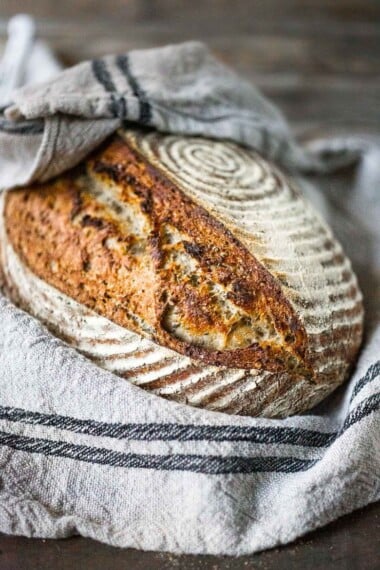

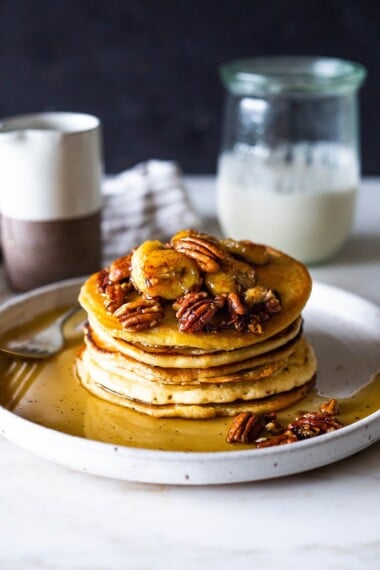
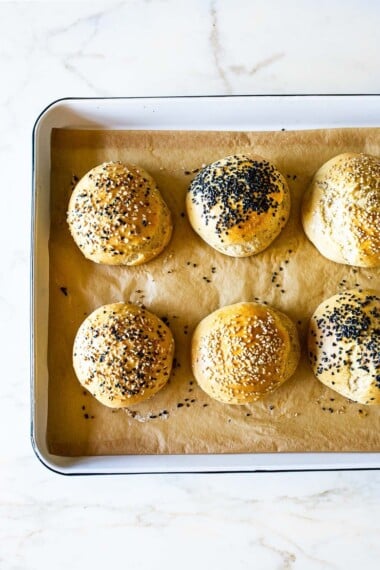







Wow thats an extensive report on yeast starter fermentation thingy.
By the way you dont make yeast by mixing flour and water, yeast is a living organism that is floating around along with other everyday bacteria. It is attracted to the flour water mixture.
It then makes a home and multiplies and grows.
One more question. When we are going to put it in the fridge, do we feed it and then put in fridge, or put it in there hungry to start?
Thank you so much for this help. I have tried this many times and it never worked but this time it did. One note that may help others. I keep my home very cool, about 70 degreeds most day and cooler at night, so the first few times I tried nothing every happend. I started putting the fed start into my garage where it was much warmer, maybe around 80 degrees or more, and wow that make all the difference in the world. It worked perfectly after that.
Yes temerature really determines the timing of the feedings. If you are not going to use the starter for a week, feed it first. If you’ll use it within a day or two, you can put it in hungry.
Why do you change the ratio of starter in your last feeding? I am not at the point of using my starter to bake my first loaf, so I plan on putting the remaining starter in the fridge for now. When I am ready to feed it, do I go back to the 1/2 cup starter, 1/2 water and 120 grams of flour to feed or do I use teh 1/3 cup starter version like you do in the “last” feeding?
You’ll go back the the 1/2 cup. The last feeding before baking your first loaf is just giving it a little extra boost of “food”.
Nice
My sourdough starter worked out perfectly I started it with rye and kept feeding it with spelt flour. Just wondering will this work with whole grain gluten free flour? If so, which flour would you recommend? Also, once you take out some starter in the fridge to make sourdough do you then replace same quantity of flour you’ve removed from the jar? Or do you continue adding say 120g of water and flour each time?
Great to hear Kelly! You can feed it with whatever works best and you don’t have to stick with one flour. You can alternate, or blend. I have not tried the bread recipe with GF flour, so you may need to experiment here a bit. Whenever you feed, discard all but 1/2 cup of your starter, add 1/2 cup water and 1 cup flour.
My starter is rising and falling predictably but it seems like it stays risen for a long long time. It takes nearly 24 hours to complete one rise and fall cycle. When it does fall, it is still very thick and sticky, not thin like you say when it is hungry. I am using 1/2 cup starter + 1/2 cup water + 1 cup flour. What am I doing wrong?
It just may be the temperature there-you are doing nothing wrong. It sounds fine! Is it doubling within 6 hours?
OMG!! Day 2 and the starter filled my quart jar! Is this very good, very bad or in the middle of good vs bad? I am using rye flour.
It is great!
Hello!
I have been on the sourdough journey for only a little while. Some months back I tried 3 times and could not get it to work. I decided to try again and this time it is working (mostly). This time I have been weighing the amounts of flour and water and believe that has made a huge difference. I started with one starter using only whole wheat flour. I then divided it into two and slowly converted one to white bread flour and the other to half white half wheat flour. They were very active, needing to be fed 3 times in 24 hours. I am on Day 8 and this morning I noticed the White flour one had not risen nearly as much as normal. It had doubled and was runny so I fed it (and also used some in bread dough). It has been 6 hours and I cannot see any action in it other than some bubbles. It has not risen but it is getting runnier as if it is digesting the flour. Is this normal? Do I need to do something to help it get back to doubling in size? I was wanting to put it in the fridge after the next feeding but now I am nervous about doing that. Will it be ok if I do?
It sounds like it is the flour. Yes,it is ok to put it in the fridge if you need to- totally ok to take a break- but if it is not doubling within 6 hours of feeding, you’ll have problems with making bread. I would try letting it get very very hungry before feeding next time and mixing in a whole grain flour.
Sylvia, absolutely loved this recipe, When I first began the process on day 1, I tried to create a very warm environment for my starter to sit in by heating up my microwave with a glass of water , taking out the glass of water and discarding it and then putting the starter in the preheated microwave. To be clear, I did not microwave the starter mix which I had in a 24 oz glass jar with cognitionboosters.com lightly on top. Using this process, on day 1, the starter was very active and very bubbly with lots of holes and doubling in size. It never fell, but at the appointed times when I was to feed the starter, it had a very intense smell.
Great to hear!
Hi sylvia,
Thanks for sharing the wonderful experience of making sourdough starter, though I am keeping track of mine, but mine is behaving quite different, it was very active and hungry for the first 2 days than it slowed down, it did rise and increase in volume but slides down very little. I am in day 5 now, though it looks healthy but I am not sure when its ready to use.
P.s, I live in Pakistan and its very hot and humid here.
Hi Sofia! I would give it a few more days. It is ready when it doubles within 6 hours of feeding. 🙂
Hi Sylvia,
First of all thank you for the detailed recipe and information, it has been very helpful.
I am running into an issue, I have followed the directions exactly for the first 3 days without issue, on day 4 my starter rose about 1/3 instead of doubling, this was after 15 hours. I monitored it after 12 hours waiting for it to increase more but it didn’t. I ended up feeding it. Now day 5 and it has been 19 hours with barely any increase at all (no slide down marks either). The top looks runny and pourable and I’m wondering if I’m overanalyIng and should just stick with the 12 your feedings until ready? I was trying to wait until it doubled to feed because I didn’t want to overfeesd.
Thank you.
You are on the right track Eddy. Don’t stick with the schedule- just watch your starter and feed only when showing signs of hunger. It’s better to wait and let it get really hungry than overfeed, which will cause lethargy. Sometimes this can take 24 hours, especially as days and nights get cooler. Just keep going. 🙂
Thank you for sharing your recipes! I LOVE this sourdough bread! I have been making it with caraway, fennel, and chia seeds in the amount you recommended. I would like to try a loaf using herbs like the rosemary, thyme, and sage but don’t feel confident in guessing the right amount or combination to use. Do you have a suggestion to start with?
If using fresh herbs, start with a tablespoon or two, or if using dried herbs, try a 1-2 teaspoons.
Hi there– I am on day 7 presently. The starter does not really rise, but it bubbles and gets obviously hungry (liquid on top) at about 24 hours. I’ve not implemented a 2x/day feed yet since it is going so slow. I am in Seattle, so it is a bit cooler, though I am checking the temperature of the starter and it hovers around 75 degrees F. Should I keep going and see what happens over the next few days, or try something else? Thank you!
Give it a couple more days, then try switching up the flour? Anything freshly milled, or mixing in rye or whole grain.
Hi Sylvia,
I started growing a sour dough culture using the Tartine Bakery (SF) recipe a couple of years back. I had mixed success and made a few loaves that were too hard for my wife. I came across your website a little over a month ago and started a culture with whole wheat and bread flour (both King Arthur). Only one day the culture doubled and settled down, but most days it barely goes up and down. After 10 days on the counter, I split it and put half in the fridge and keep half on the counter. Regardless of rise (and I forgot to test for float the first two times) I have baked 3 sourdough rolls, using your recipe and also used your pancake recipe with the extra culture. I’m experimenting with different types and quantities of flour and even different levels of lukewarm temperature. I even took an open jar of the culture and walked around the yard to pick up some wild yeasts from the air.
Still, all the loaves and the pancakes were so good. My wife and my son both loved them. Thank you for sharing your expertise with us. I can’t wait to try your other recipes. Kind regards.
Thanks so much, Jalal, appreciate you sharing. If you find any freshly milled flour to add to your starter it may give it a nice boost. 🙂 All the best on your sourdough journey.
Hi Sylvia. Yesterday I used 30% white whole wheat, 70% bread flour (both King Arthur), 100% water, and 20% starter (weight: whole wheat 120g, bread flour 280g, filtered water 400g 110° F, and starter 80g) and left it in a tall mason jar covered with a damp cloth overnight on the counter. The temperature in my kitchen hovers between 76-78° F. This morning it has doubled in size. Excited.😁. After I made the mix I realized I’d gone overboard with the weights. I will cut everything in half when I refresh it this morning. I will try to find some fresh milled flour. Thank you again. Best wishes.
Thanks Jalal!
And I made your scones yesterday with the starter I mentioned earlier. My wife, who is an excellent cook, said it’s the best thing that’s come out of our kitchen!!! They were sooo good. I had some frozen raspberries and did use the butter for the glaze. I can’t wait to try all your other recipes. Much thanks again.
I’m so happy you and your wife enjoyed this Jalal!
Thank you again. Hopefully my last question- now that my starter is in the fridge. I understand that i need to feed it once a week. Does that mean, i take 1/2 cup of cold starter, feed it and then leave it out for 8 hours. Or can i feed and refrigerate it immediately and then feed again after a week?
You can feed it and put it right back in ( and feed it again in a week) if not using it right away.
After feeding and keeping it back in Fridge, when can I bake again?
You can bake any time, just make sure the starter has peaked ( pull it out of the fridge, let it peak), you don’t want to use starter for bread dough when it is not “hungry”.
Hi, I had a question about maintenance phase. I like to put it straight back in the fridge when I’ve fed it, but I was wondering if it should be put in an airtight container or if the lid should be left loose. Thank you!
I leave it loose. 🙂
Hi Sylvia,
Thanks for your response to previous question. So i am in Day 7 and this morning my starter was overflowing. I fed my started at 7.45 am ans now its more than doubled and i think its still raising (12.22p). I fear it will overflow. I want to make the bread tonight but not sure if i should be keeping my starter in fridge at this time or not. Also, you suggested that we should be baking with a slightly hungry starter. What do you recommend?
You are fine to bake tonight. I would keep it out, so it gets a little hungry before you make the dough. 😉
Day 3 here! Just opened mine to feed it and woooo it smells. Will toss it and restart in the morning. Thank you for the trouble shooting tips!!!
Hi Sylvia, i fed my started on Day 4 morning and since then it has not doubled. Today is Day 5 and i still dont see it doubli g. There are lots of bubbles on top but not sign of sliding down either. Should I feed my starter?
Hi Naz, look for signs of hunger. Is it liquidy enough to pour out of the jar or water on top? If so, feed. 😉
Hi, I have baked my first sourdough bread using your starter and overnight sourdough guide, I was in love! It came out beautiful!
I put the remainder of the starter in the fridge for one week, and took it out for my second try at baking.
I fed it, but after almost 24hrs it has almost not risen. There’s definitely signs of hunger: lots of bubbles at the top.
Do I just continue feeding it until it starts to double?
Yes, I would leave it out a few days and strengthen it- only feeding when hungry.
Hi! Hope you’re having a great day..
I have a question..
In my local town it’s so hard to find Whole Grain Flour, but we do be having a lot of Whole Wheat Flour. My question is, can I start my sourdough starter with the whole wheat flour instead? Do I need to add more water or less flour since it’s so thick ?
N.B. when I weighed 120 g of water and the same amount of whole wheat flour, the flour was less that 1 cup, and when I mixed them together they made a kinda thicker than yours paste
Thank you so much
Have a wonderful day
Yes, that is fine to use whole wheat, and totally fine to add more liquid so it looks more like the consistency of the video. 🙂
Hi! Everything is going well with my starter (on day 5), but I am running out of bread flour and my local grocery store is currently out of stock. If I cannot find more, what would be the best substitute until I can restock?
Whole wheat or a blend of whole wheat and white.
Fantastic, thank you!
As I’ve been researching “starters” for a while, your instructions/video is one of the more informative and detailed ones out there, thank you for this Sylvia! I purchased some Weck jars 🙂
My question is (and I’m not savvy on the subject, a little confused, lol) and which I haven’t found a person to really answer, can you utilize a “sourdough” starter to make regular white sandwich bread, white hamburger buns and Italian white bread etc…? Perhaps you mentioned this and I missed it? Don’t get me wrong I love sourdough bread too 🙂
Yes you can. Sourdough just acts as the yeast here. Timing will be different. But it doesn’t necessarily have to make the bread sour. 🙂
Ugh -.-‘ Somethings happened with mine. It started off so well! Now it’s been about 3 weeks.. ( I put it in the fridge for a week because I got frustrated)
It rises.. Hardly falls, but will if I leave it for longer time.. & it does not float.. It smells fermented.. In the end I only feed it about once a day because the slow rise fall.. I am in a warm climate .. Please help!
Sorry about that. It seems like you are on the right track though! Does it double within 6 hours of feeding? Leave it out and time how long it takes to double and report back. Let me know. 🙂 You can do this!
Yes , it doubles in size but does not go down.
I tried 2 days ago to mix it and leave it to get hungry.. It rose a little a again.. Did not float.. Got frustrated put it in the fridge.. Took it out again.. fed it. And it’s double the size.
Ok if it doubles within 6 hours of feeding it is ok to use for baking!
I can cook even though it does not pass the float test?
So when would I make the overnight bread?
I would feed 6Hr before?
You can use it even it doesn’t float as long as it doubles within 6 hours of feeding. I would wait to use the starter until it is hungry. Use after it peaks and starts to sink. For example, feed starter early in the morning, let it peak during the day, make the dough at night.
Hello! I started my starter in July and have been feeding 2 x day. Still haven’t used as been too busy to move on to learning to bake bread. The last week or 2, the starter smells like acetone. I tried a backing off to 1 x day and back up to 2 x day, still smells. Start over or okay to use? It’s rising and falling, just smells different than before : (
Thanks!
Does it double within 6 hours of feeding? If so, put it in the fridge and maybe give it a break for 5-7 days, refeed. Measure the time it takes to double. Honestly, I would just store it in the fridge if you are not using it? you’ll use less flour.